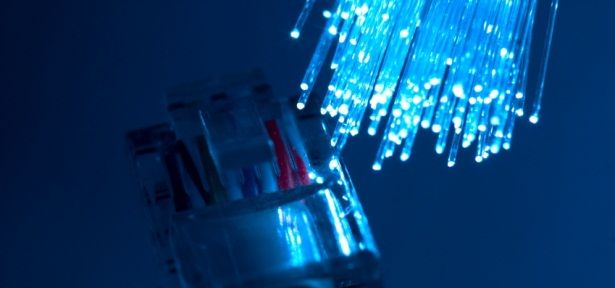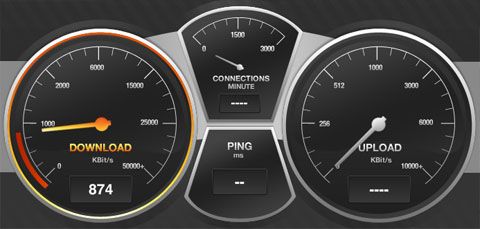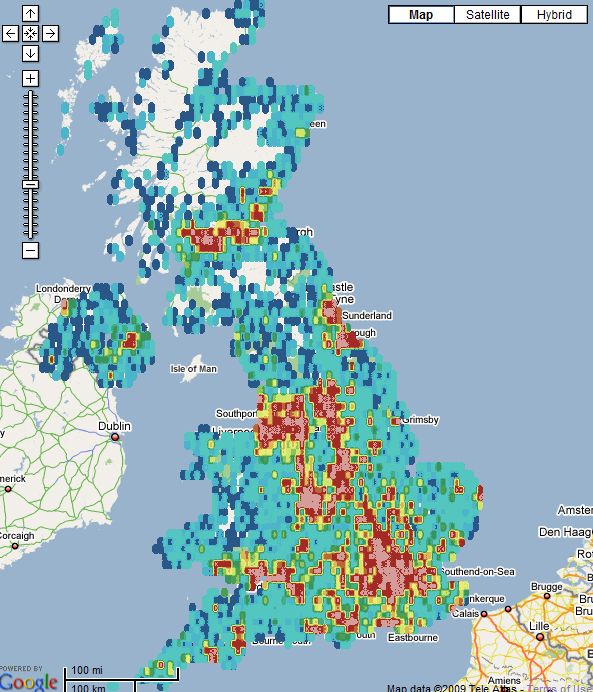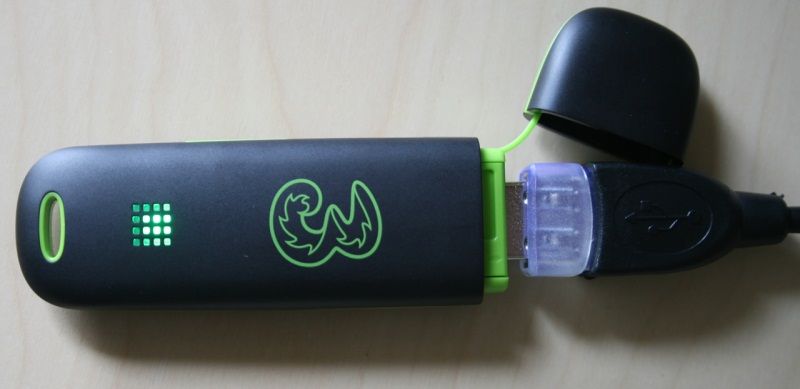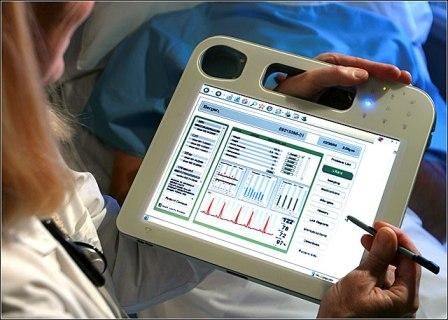There were a number of key themes that came up as we spoke to all our futurologists and industry experts for Future Week and nearly every one of them relied on the existence of a connected world. In terms of our history, it's been a matter of nanoseconds since we invented the Internet. It is our era's fire, our steam engine, our connected revolution and we're only just beginning to discover what it can do for us.
As its infrastructure grows with new standards like Wi-Fi, fibre, satellite and mobile broadband, the world opens up for not just people but objects the world over, enabling them to communicate with one another. Possibilities become limitless and horizons stretch further than we can see, but all this relies on actually being able to get a connection wherever we our and at both the speed and quality we need.
At the moment, we have a steady fixed line service with the vast majority of homes covered and a 3G network that's patchy to say the least, but what about 5 years' time? What will the coverage maps look like then? How fast will we have the data we need at our fingertips and what will we be able to do with it? We spoke to four experts from BT, O2, 3 and the Open Mobile Terminal Platform to find out.
Speed
The first question burning upon the lips of most people reading this is "How fast will my connection be?". It was our first question as well. Right now we know that the the majority of homes in all countries except South Korea and Japan are connected at less than 5Mbps. If you looked at a straight average it's probably far greater with the figures skewed by high speed services in the realm of 50Mbps and beyond, but that's not what most people are getting.
In the UK, if you're willing to pay top dollar, BT's Infinity service is advertised at 40Mbps. Virgin Media offers 20 and 50Mbps fibre services at the moment, has promised to begin rolling out 100Mbps this year and we've just seen tests of 200Mbps connection as well. Tests of peak speeds, of course, are all very well and good, but what about the practical realities?
According to BT Group Strategy Director Tim Whitley, the answer for fixed line speeds will continue to be slightly different for everybody.
"We believe that the broadband landscape in the UK will be a 'mixed economy', with both fibre-based and advanced copper broadband services providing faster speeds. By 2012, super-fast broadband from BT will be available to 40%+ of the UK, and will include both 'Fibre to the Premises' delivering speeds of up to 100Mbps and 'Fibre to the Cabinet' providing up to 40Mbps downstream, potentially rising to 60Mbps in the future".
Naturally, the key to these promises is always the use of terms like "up to" but fibre to premises - that is, not shared and not having to end up losing bandwidth by virtue of being any distance away from an exchange or box - is an exciting prospect for fixed line, even if it's anywhere close to that magic 100 figure - and that's by 2012. Just as appealing is the prospect of 10Mbps upstream speeds that BT fibre should offer as well. Again, it's an "up to" figure but, even if we have that, it would already be many times faster than what we get at the moment. No more long waits for uploading HD video.
Of course the caveat to all this from Whitely is that the majority of UK consumers will only be able to get the advanced copper broadband services (ADSL2+) that has headline speeds up to 20Mbps. But, with government targets to have fibre to 90% of UK homes by 2017, we can expect ADSL2+ to have shifted to a minority by our 2015 deadline - a good place to be.
So, what of mobile broadband data speeds? The HSDPA network has just about lifted the on-the-go browsing experience from poxy to bearable at present. Would it be asking too much to have graduated to adequate or even good in 5 years' time? Fortunately, executives both at 3 and O2 agreed that we should have so called 4G services like LTE (Long Term Evolution) well in place by 2015. According to chief technical officer of 3, Graham Baxter, LTE should be prevalent, but it's not the technology that's holding it up.
"What's stopping LTE in the UK today is available spectrum. Digital Britain is the key to that. If it gets through, then the spectrum will be auctioned off by 2011 and with the refarming as well, then I'd expect roll out of LTE in 2012, so it should be well established in 2015".
Peak tests of LTE have produced download speeds of 150Mbps, but don't be hooked in or blinded by the numbers here. This represents the kind of ideal scenario where you're sitting with your back up against the mast with unlimited personal access and no one else for tens of miles around using the same cell. It's never going to happen. The reality, according to Baxter, is more likely a very reasonably sounding 18Mbps with an impressive uplink of around 9Mbps. The best part is that these are not peaks. These are averages.
With LTE and fibre very much a part of our data infrastructure by 2015, one might finally think that our thirst for speed would be satisfied, but not so according to Tim Haysom of mobile operators' forum OMPT.
"When are users going to stop wanting higher speeds? Well, they never will. The trouble is that data speeds are a bit of a red herring. It's more important that someone is able to have a mobile connection of a reasonable speed that works for a reasonable amount of time".
So, if this number chase is going the same way as megapixels in the camera world, then the real issue has to be consistency.
Coverage
We already know that fibre isn't going to have reached all homes in the UK by 2015. There's a large case of economics and civil engineering to consider with a predicted £20bn to drum up to make it all possible and the time needed to dig the holes. However, when 5 years has passed, the majority of the country should be fairly happy with their fixed line proposition. The big question for mobile broadband is really how many of us will be reaping the benefits of this 4G technology, LTE.
"At the moment we have islands of 3G in a sea of 2G and these islands will start to link up", describes Mike Short of O2. "Then from 2013 onwards we'll start to see islands of LTE in a sea of 3G with LTE likely in capital cities in 2015 and, by that time, 3G coverage will be closer to GSM coverage of today in Western Europe, North America and North East Asia".
Certainly good news for those in urban areas then, but what of the fisherman up in Kinlochbervie or a sheep farmer of North Wales? Well, according to Baxter, the 3 network already has 85% of indoor coverage. The problem there though is that the overwhelming majority of indoor spaces in the UK are in large urban clutches - towns and cities - so the figure is a little misleading. But, all the same, once the analogue TV spectrum is re-purposed and some of the old 2G network re-farmed, then that figure would rise to something like 95 or 98% with those people receiving the 2Mbps service minimum outlined in the Digital Britain report.
3G itself will also improve in performance, as it does already each year, and 2015 should offer average stats of 4Mbps uploads and 2.5Mbps in the downlink for that standard alone. It may not quite cover all our friends in the most extreme parts of the wilds, but you should be able to watch high-res YouTube quite comfortably on your phone in plenty of rural areas. For those places outside the realms of even 3G, then satellite will make up the remainder. So, to complete Short's picture - islands of LTE, in a sea of 3G surrounded by the satellite mountains.
So, it seems that coverage issues, like speed are also on the decline already with bright futures for both by our 5-year marker. That then leaves the issue of capacity which, it seems, will all come down to money - yours and ours.
Cost
Just because the bandwidth is there, it doesn't mean that we can all fill our boots with as much of it as we like come 2015. The fact is that each cell has only a limited amount and it wouldn't be fair to let one person sit at the mast and hog the lot. For that reason we're still going to have download limits on our accounts. According to Tim Haysom, though, these limits will get laxer and laxer as the sites become more and more efficient.
Perhaps most interestingly of all, he proposes a scenario of large choice of different broadband packages to suit the needs of the individual customer. People wanting to do online gaming in real-time on the hoof would need top speeds and low latencies and will probably pay premium rates for high-end packages. Those streaming music might well pay less needing still reasonable speeds, but with plenty of room for flexibility on latency because of caching information on the device itself. And then the majority of people might be happy to pay much less for a service that just requires the odd burst of information up and down to keep some GPS or other data hungry smartphone apps on the ball, as well as some decent, steady browsing.
Graham Baxter sees further alternatives with the idea of "value added services, rather than just the bit pipe". We can look to 3's current ideas of Spotify and Skype phones and mapping packages for some clues as to what else will be thrown into the bargain, as well as some possible subsidies if you're willing to put up with contextual advertising. After all, the networks can provide companies with the information they need to pick products relevant to you without breaching your identity at all. However the price plans are organised there is one thing that Baxter says we can be fairly certain of and that's that insane roaming charges should be a thing of the past.
"I can't see the current situation sustainable in 2015. Underlying costs of internal connections back home just don't justify the inflated prices and where there's no justification, it's only a matter of time before there's change. It's an EU issue at the moment; one for the politicians, but I'd be very surprised if it was still there in 5 years' time."
Oh, and if you're hoping for fixed line to go down in price a great deal, think again. We can already see each service provider's ecosystem growing with telephone, TV, internet and even mobile now all bundled in. Think more of the same plus extra speed and you're answer will be somewhere equivalent to what you're already shelling out, only integrated more, and making a comprehensive price comparison even trickier.
Fixed vs Mobile
With fixed line service speeds seemingly heading for the clouds, while embedding themselves as part of your home entertainment package, the picture you get is one of hard wired internet necessity, but imagine the situation where you live in a house in a city in 2015 with 18Mbps LTE coverage. Why would you bother paying for both a fixed line and mobile broadband subscriptions?
Typically, of course, it comes down to who you are, how much you've got and what you want to do with your connection.
"Mobile is compliment to fixed line", admits Baxter despite mobile broadband being 3's raison d'etre ever since it was conceived. "It depends on the user case. Our unique selling point is mobility but there are niche markets for supplying homes too - a student sharing a house might be willing to have more modest speeds for a lower cost or migrant workers who don't have three months' worth of utility bills to show a fixed line ISP. I would say people who want to stream TV will always go fixed but, if you're not in a fibre area, then maybe you might consider the mobile data network instead".
O2, it seems, are more hard line on the matter with a point towards the decline already present in fixed line services.
"The balance is moving just as it did between fixed line phones and mobile. What fixed line has to offer at the moment is very high speeds but the wireless industry is catching up and it should take over wired in five years' time. It depends on the country and available spectrum".
And, of course, you don't need us to tell you BT's ideas on the future of their service. Suffice to say plenty of mentions of bandwidth hungry applications and all those Wi-Fi hotspots out there.
From our point of view, 5 years just seems too short a time to switch to just one. With more and more objects in the home - with particular reference to the TV - becoming connected, the need for a reliable and fast internet connection is simply going to grow. Besides, should the demand ever decline, chances are the price would too or it will simply shrink under the cover of the cost of a newer and greater service. Think minutes and texts in your mobile plan when data came in.
Applications
So, if we're going to have all the bandwidth we need pretty much anywhere we want it, exactly what are we going to be using it for? It almost went without saying for all of our experts that we'd be streaming HD video content both on the hoof and in the home. Playing real-time games with other players on the other side of the globe was another given.
For BT and fixed line, Whitley outlined the goals of "enabling people to share user-generated video content, hold high-definition video calls, and also to support home-workers that require broadband speeds that are comparable to those at the office". The mobile networks actually had little to say on the matter beyond streaming and gaming. To be fair, at the moment, there's little else that would require the advances in speed technology.
In fact, the only new connected space, as pointing out by Mike Short, is going to be the car.
"It's the internet on wheels - connected cars in 2015. We have all the motorways and roads covered in Western Europe. Car manufacturers have much longer product cycles of 8-12 years but they will be catching up by then. They can already see the advantages to real time navigation and traffic and a whole host of possible applications to be connected in the car". But more on that one later in the Future Week.
The Future
The final question we put to our experts was simple - if this was the picture in 2015, what would we be the internet infrastructure challenges facing us then? The obvious reply was the blanket coverage of LTE and one can only wonder if we'd be looking forward to islands of whatever the 5G experience might be in 2020 and beyond.
The truth is that, at the moment, the networks can only work towards supplying us with the tools for what we want to do. If streaming high definition content is the most bandwidth hungry application we can use at the moment, then that's all we're going to get. With the coverage and capacity issues dropping off by 2015, we'll then have the ubiquity in service that developers have been looking for, giving us more and more profound apps as well as a complete framework for a much talked about "internet of things" - a world where every object in our lives is connected to the data it needs to add new dimensions to its uses.
Once our ideas and applications have caught up with the technology we possess, then doubtless we'll stretch out again and, who knows, in 5 or 10 years' time it could be streaming holographic 3D virtual worlds that we're looking to accomplish needs at home and on the move. Let's hope battery technology has come on a way by then too, in that case.
If you enjoyed this article, then head over to our Future Week homepage where you'll find a collection of features on what gadgets will be like in the year 2015.

